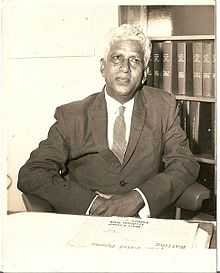James Madhavan
| James Madhavan | |
|---|---|
 | |
| Member of Legislative Council (Fiji) | |
| In office 1947–1972 | |
| Member of Executive Council (Fiji) | |
| In office 1950–1956 | |
| Preceded by | A.D. Patel |
| Succeeded by | Vishnu Deo |
| Personal details | |
| Born | Fiji |
| Died | Fiji |
| Political party | National Federation Party |
| Spouse(s) | Eunice Madhavan |
| Residence | Labasa, Fiji |
| Profession | Teacher, Trade Unionist |
| Religion | Christian |
James Madhavan was one of the longest serving politicians in Fiji. He initially was a primary school teacher but when the Maha Sangh was formed in Labasa was one of its earliest members. Unlike, Viti Levu where it was mainly supported by South Indians, the Maha Sangh in Labasa had support from a wide cross-section of the Fiji Indian community. James Madhavan was able to use this to propel himself into the Legislative Council.
He entered the Legislative Council in 1947 and remained a member of Parliament until his death in 1973. He aligned himself with A.D. Patel against Vishnu Deo, but unlike A.D. Patel who lost his seat when Vishnu Deo turned against him, Madhavan was able to retain his Eastern Indian Division[1] seat. After A.D. Patel's defeat in 1950, Madhavan was selected as the Indian representative in the Executive Council.
Madhavan was the leader of Maha Sangh in Vanua Levu and when the organisation split into two opposing factions, he registered a new association known as the Vanua Levu Farmers Union.[2]
He contested the 1963 election, under the banner of Citizens Federation, together with A.D. Patel and Sidiq Koya. All three won convincingly and went on to form the Federation Party in 1964.
He was an active member of the Fiji Teachers Union and was its president in the 1950s and early-1960s, retiring from the position in 1967.[3]
References
- ↑ "Fiji Elections Archive: Elections for the Legislative Council, Eastern Division 1929 - 1959". Archived from the original on 2009-10-25.
- ↑ Industrial associations and local politics
- ↑ Mamak, Alexander (1978). Colour Culture & Conflict. Australia: Pergamon Press. pp. 82–83. ISBN 0-08-023353-8.